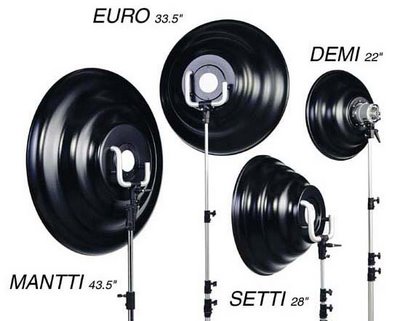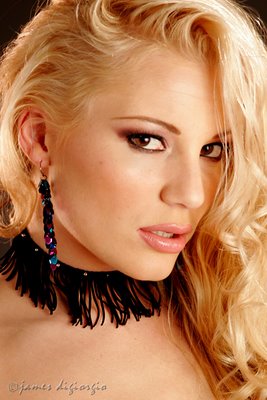
I love my Mola 33.5" Euro beauty dish. I don't mean I like it, I love it! It has become the pivotal, pre-eminent, light modifier in nearly all my glamour and tease photography.
Before I became a Mola guy, I used big umbrellas and softboxes of all shapes and sizes as keys or mainlights. But once I began using a Mola dish, the softboxes and the umbrellas I once used to modify my mainlight were put away and I've rarely brought them out except when traveling to exterior or interior locations away from the studio.
As you can see in the image above, Mola manufactures a variety of dish sizes (i.e., diameters) for their beauty dish line. I'm wondering: If Mola someday decides to make an even larger dish than the 43.5" Mantti, will they call it a Yetti? (That was a joke, BTW.)
The Mola dish is truly a versatile modifier. I'll admit, it's not cheap. But if you're serious about glamour, portrait, beauty, or fashion photography, and you shoot often enough in a studio environment, there isn't a light modifier I'd recommend more enthusiastically than a Mola beauty dish.
I know other manufacturers produce and sell their own lines of beauty dishes. Hensel, for example, makes a beauty dish. But since I've never used one, or any other manufacturer's dish, I can't comment on their prowess when it comes to transforming a bare bulb into soft, creamy, luxurious light.
When you compare Mola's dishes with others, the first thing you'll notice is Mola's unique and patented sci-fi shape. I'm not much of a science guy--except for science fiction because you can make it up as you go along--but from what I understand, Mola's odd, undulated, shape is designed to capture light (which, by nature, wants to scatter) and redirect it towards the subject. It also shapes the light by creating a 360° smoothly-graduated and feathered edge that is about a half-stop less than the light at its center. Cool, huh?
Mola's design includes an opalescent glass baffle at its center. The baffle works in concert with the dish's shape to produce the beautful lighting characteristics that so many photographers, professionals as well as hobbyists, admire. I also use the baffle to warm or cool the light by affixing an appropriate gel. Often, for glamour and tease shots, I'll clip a small piece of Bastard Amber, about four-inches by four-inches, to the front of the glass. To my eye, this produces a very pleasing warmth to the model's skin-tones that seems, at least to me, a bit more subtle than the same colored gel on other modifiers. I think I read somewhere that the paint used on the interior of a Mola dish is patented. The paint also has slight warming characteristics.
I keep my Mola mounted on the end of a grip arm which extends from a knuckle on a junior stand. This allows for limited booming as grip arms are only about 4' long. Since the junior stand is on wheels, I can easily move it about. The dish comes with a swivel handle that allows (limited) tilting and panning depending on how the dish is set and oriented on the stand. I've also discovered the Mola's optimal range, that is, for producing its signature lighting characteristics, seems to be between 3' and 5' from the subject.
Mola's Euro beauty dish has become one of those great additions to my studio; one that I really don't know how I got along without. In fact, I intend to buy another, probably a smaller dish, when my wallet permits. You can visit Mola's site by clicking HERE. And here's a headshot of Aurora lit with my Mola beauty dish which you can see if look really, really close into the catchlights in Aurora's eyes. MUA was Terese Heddon.


12 comments:
When you do have to travel, what is your preferred key light modifier?
What are some of the reasons to go bigger, does it give softer lighting, does it spread the light further like a flood light.
When you do have to travel, what is your preferred key light modifier?
probably a 48" octagon softbox for the key and a small. maybe 12" umbrella for a hairlight. I'll also sometimes bring some other lights for kickers. These, with plastic grids attached to the front to keep their light more focused.
What are some of the reasons to go bigger, does it give softer lighting, does it spread the light further like a flood light.
yeah, basically, the larger the diameter of the dish the larger the diameter of the light it's going to throw. obviously, you can move any light further from the subject and get more spread, i.e., light a larger area with it, but you'll sacrifice "softness" and diffusion and increase hard shadows.
an email from Walter Melrose, photographer and inventor of Mola Softlights:
Dear Jimmy:
Thank you for the kind review, I'm glad you enjoy our product and have
shared your love of the light with some many.
I am not a Blogger and this is the first Blog I have visited.
As a shooter myself being honest and open about the work we shoot and how we shoot it is not something most of us are comfortable with. Most if not all of our clients keep there love of the light a secret for fear someone will buy a Mola and copy there style.
Your honesty is refreshing.
Thank you
Walter Melrose
Mola Inc.
I'm a relatively novice photographer. On the strength of your review I rented one from Samy's in Los Angeles. Now I want one for my very own.
http://img.photobucket.com/albums/v228/jfrancis/Amber/Amber_3177_c_600.jpg
http://img.photobucket.com/albums/v228/jfrancis/Betcee/Betcee_3124_600.jpg
http://img.photobucket.com/albums/v228/jfrancis/frosting/frosting_3288_600.jpg
Thank you.
Joseph Francis
http://www.digitalartform.com
Why can't you travel on location with the BD? I was thinking of going this route as I am not a fan of softboxes
Why can't you travel on location with the BD?
I've done so many times. But it takes up so much room in the backseat of my car that I find myself finding excuses not to bring it along. I wish I had a better reason than that but I don't.
Hi Jimmy. What brand and model is the Junior stand you're using for your Mola Euro? Thanks so much!
@RovingRooster: A Matthews 2-riser with wheels.
I shot in a friend's studio last week and used a beauty dish for the first time. It was a 22-inch dish with a 20-degree (I think) grid mounted on an Einstein. I was shooting mostly full-length shots, so I got a much more directional light than is normally associated with dishes – especially with the grid.
However, I like the strong directional look – and the rapid light fall-off that goes with it – for *some* things( such as low-key). I'd probably rather have the wraparound look more often.
Normally I shoot with Photogenic Solairs and Powerlights. I would have rushed out and bought a Photogenic dish, but there is no grid for it. While researching dishes, I came across some information about the Mola dishes – and the plethora of sizes.
I have several questions about dishes – enough that I hope it will inspire you to write a follow-up article about them. This is the first time I've been on your site, other than by clicking on the links you post on supershoots.net from time to time. I found a link to this thread on modelmayhem.
With several manufacturers, four sizes and silver vs. white to choose from, dishes are expensive enough that I don't want to learn about them by trial and error.
Some of my questions:
1) I shoot everything from beauty and headshots to full-length fashion for model portfolios. Where do I start?
2) Do you prefer reflectors with silver or white interiors? If you've used both, can you direct me to some examples of each?
3) As far as I can tell, there are no grids for the Mola dishes. Does their patented design eliminate the need for them? If so, how does this affect the softness and wraparound effect of the dishes?
4) Since it's the Mola dish itself (in the case of the larger Molas) that mounts to the grip arm, is mounting a 1000-w/s Solair (7 pounds) to the dish going to create problems?
5) How do you stabilize your C-stand with the heavier dishes? (i.e., how many pounds of sand?)
6) I read in a couple of places that the Kacey dishes are very similar to the Mola dishes, with the main differences being the price and the fact that the 45-inch Kacey reflector is made of plastic (i.e., the 45-inch Kacey weighs less and is less prone to denting than the 43.5-inch Mola). Do you know anything about the Kacey dishes?
7) I've heard that there are cases for transporting beauty dishes, but nobody seems to know who makes them. Do you know? Any preferences?
Thanks for any help.
Dave
Hey Dave! I'll try taking a stab at your questions but please don't absolutely hold me to my answers.
1) BDs are very popular for fashion and other model images and for good reason, they generally produce soft, creamy light which, as you mentioned, falls off rather rapidly keeping the viewers' eyes where you want them. I'm a big fan of Mola's dishes. For one thing, the interior paint (which they say is patented) is slightly warm and reflects beautifully off of skin. Sometimes, I warm it up even more with a small piece of gel, usually bastard amber, taped to the glass baffle in front of the light.
2) If I want a slightly harder light that will produce more specular highlights, or I'm trying to get more bounce out of the reflector, I'll go with silver. When I'm most interested in softness, i.e., more diffused light, I go with white.
3) http://www.mola-light.com/html/latest.php
4) Most people mount their Mola dishes on boom arms. That allows for adding weight to one end of the boom in order to offset the weight of the dish and the lighting instrument at the other end. I've mounted my dish both ways, i.e., with a grip arm or boom. When i've used a grip arm, I'm using a junior stand which is way heavier duty than a normal stand... plus sandbags to weight it at the bottom, whether the stand is on wheels or not.
5} See #4. I don't use C-Stands when I'm using my Mola.
6) I've heard of the Kacey dishes but have never seen one in use. Consequently, I'm unfamiliar with them. Manufacturing a dish out of a rugged and durable plastic material, tho, doesn't seem like a bad idea. It certainly would weigh less! I'm wondering how rigid the Kacey dishes are? Often enough, I clamp some foam core or bead board top and bottom to either clamshell or book-end the light.
7) Don't know about cases specifically designed for the Mola dishes altho I once saw a photographer who kept his in a case that was intended for a large drum, i.e., a drummer's drum.
Hope some of that helps.
jimmy
Post a Comment